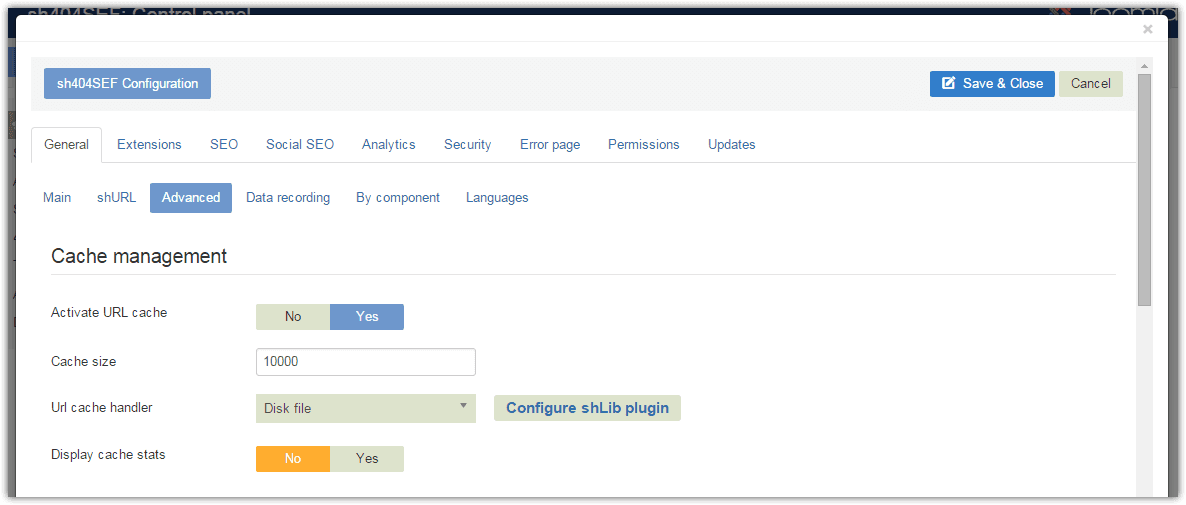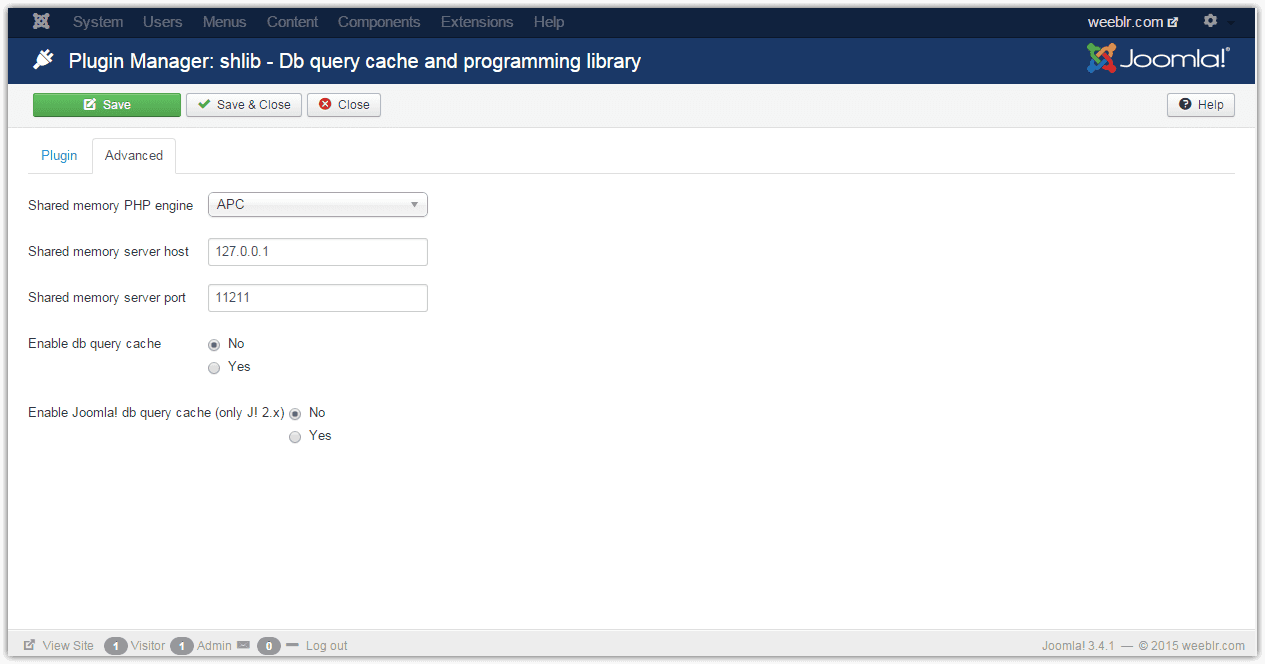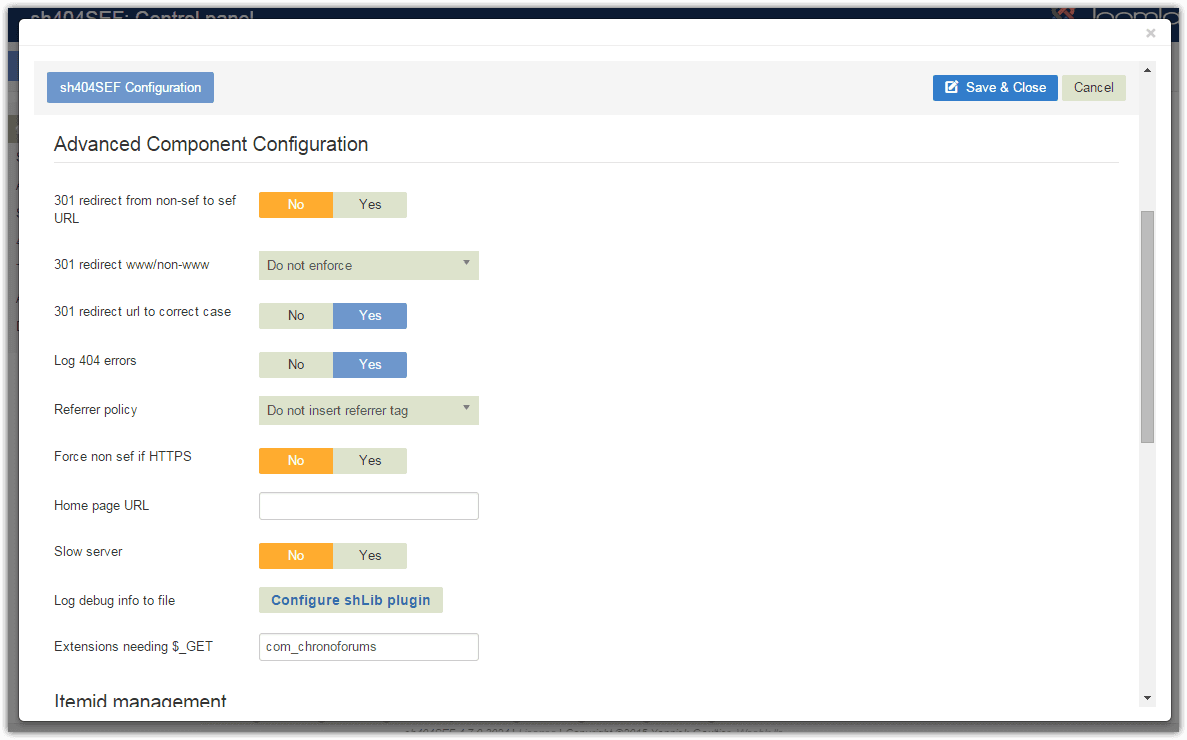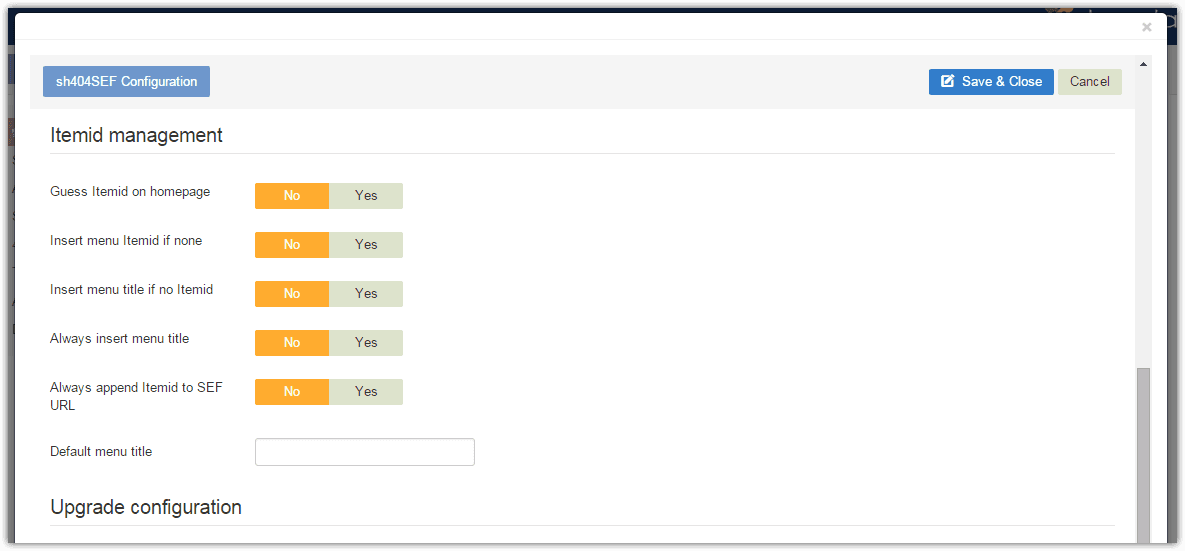SEF URLs advanced configuration
The Advanced tab of sh404SEF configuration allows you to select even more rarely used options:
Cache management (file)
As mentioned previously, sh404SEF-generated SEF URLs are stored in the database. To increase performance, they can also be cached to a disk file - by default, or to a shared-memory storage such as Memcache or APC.
The disk-based cache file is enabled by default. Its settings are visible on the screenshot and should not be modified unless you encounter issues such as write permissions on your server, or you want to switch to another storage medium.

Cache management (shared memory)
To configure another storage medium, select Shared memoryin the URL cache handler drop-down selector, then click on the button marked Configure shLib plugin.
This will take you to the plugin that handles those various storage engines:

Possible options for storage are:
- APC
- Memcache
- Memcached
- Wincache
To use one of those cache storage media, you must be running the appropriate software on your server. Except for a few selected hosting companies, you will require your own private server to do this, after proper setup and configuration.
Advanced component configuration
The settings in this section are more related to sh404SEF behavior under specific circumstances than actually building SEF URLs:

Automatic redirects
sh404SEF can perform automatically SEO-oriented redirects when it sees the need:
- non-sef to SEF: when a non-sef URL is requested (ie: a URL such as www.example.org/index.php?option=com_content&view=article&id=12&Itemid=34). This feature is disabled by default, as it is now extremely rare to encounter this situation, which was common during the Joomla! 1.0.x to 1.5.x era. The redirect will always be a 301 redirect (permanent).
- Joomla SEF to sh404SEF: when installing sh404SEF on an already existing site, some or most URLs will be modified. When this option is active, sh404SEF will attempt to perform a 301 redirect from the old Joomla SEF URLs to the new sh404SEF ones. That way, visitors and search engines won't face any 404, and will update their bookmarks and index.
The option is disabled by default and we advise to leave it that way. Enabling back the Joomla router - which is required for this redirect - generates negative sides effects mostly with 404 errors handling. The Joomla router will often consider valid some 404s and cause redirects to the home page when a 404 happens. That is highly undesirable. Only enable this feature for very specific reasons and preferably after consulting with us.
- www vs non-www: to avoid multiple URLs for the same content (sometimes wrongly referred to as duplicate content), your site should only be accessed through either the www.example.org subdomain or without any sub-domain: example.org. None is better than the other, and the choice is purely dependant on your or your users preference. However, once a choice has been made, the same access route should always be used. sh404SEF will enforce accessing your site through one or the other choice. This feature is disabled by default, as there's no way to know what's your preferred access. The redirect will always be a 301 redirect (permanent).
Though very easy to do with sh404SEF, enforcing access through either www or no-www is more efficiently done at your web server level. If you have a very busy site (several thousands visitors per day), that's probably the best way to do it.
- correct case: search engines consider www.example.org/some-page.html to be a different page than www.example.org/Some-Page.html. Just like www vs non-www, lower case URLs are not any better than capitalized URLs. What matters is to always use the same URLs to access a page. sh404SEF will do this check for you, and enforce access through the URL case as recorded in the URL database. The redirect will always be a 301 redirect (permanent).
Log 404 errors
If enabled (it is by default), 404 errors will be logged to the database, and available in the 404 error manager so that you can check on them, and possible set up redirects to an updated address. This setting should be left on. Counterintuitively, disabling it may not save CPU and increase performance, though it will usually be the case.
Referrer policy
The referrer policy settings lets you specify how the referrer information should be passed onto another website when a visitor clicks on a link on your site. This is a relatively new tag, which came about now that providing secure browsing (through https access) is becoming more and more common. By default, browsers will not pass the referrer information from an https site to an http site. However, the referrer tag lets you decide how you want referrer information from your site be passed around. Please see the W3C specification for details on each possible values for this setting.
If your site is running under HTTPS, you need to set the Referrer policy to
Origin onlyorOrigin when cross-originso that detection of whether 404s and other URLs are internal or external work. With other settings, some requests may be marked as External while they are in fact Internal, because the visitor browser will not pass the calling page information.
Others
-
Home page URL: Should be left empty except in one single situation: when you want to use a splash page: an index.html file located in the root folder of your web site, displayed before the main site is actually displayed. Very fortunately, this user-unfriendly practice is rarely seen these days, with good reasons. Please just don't use it.
- Slow server: When enabled, most backend sh404SEF pages such as the URL manager will switch to a simplified form putting less stress on the database server. This may be helpful if your site has many URLs, (several hundreds of thousands) possibly with duplicates and your server is not able to cope with that.
Itemid management
Itemid is Joomla! language for an integer number identifying a specific menu item. Joomla! uses it to figure out which modules and template should be displayed on a given page. Unfortunately, extensions sometimes have a hardtime handling Itemid, and this concept may lead to significant cases of multiple URLs for same content (also known as duplicate content). sh404SEF will almost always protect you automatically from this. Sometimes however, the settings below may help fixing issues. We don't advise to enable any of them without consulting with us first, or unless you're on a test site where you can evaluate pros and cons.
